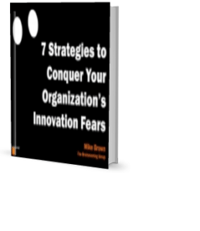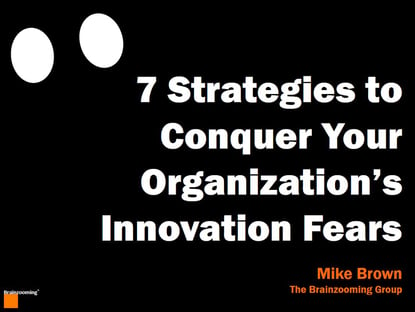The Wall Street Journal featured a piece called "Two Cheers for Failure in a Tough Drug Industry," by Jonathan D. Rockoff. The article highlighted innovation strategy options that drug companies are using to instill and support risk-taking behaviors. These companies are trying to motivate researchers facing daunting odds for bringing a drug successfully to market. Rockoff cites odds of 1 in 10,000 for drug compounds to ultimately gain regulatory approval.
The innovation strategy options include cultivating company culture, celebrating failures with parties and awards, and making sure they are failing as fast as possible with sufficient learnings.
4 Ways to Celebrate Risk Taking
While an innovation strategy that suggests throwing a party to celebrate a failed idea seems outrageous, the message from the pharma companies is that it's smart business. Even if your innovation success rate is dramatically higher, motivating employees to embrace risks vital for innovating can be challenging. It's chic for gurus to extol embracing failure. Yet, most employees have no track record of seeing peers - or anyone else - fail repeatedly as a pathway to corporate success.
Let's suspend judgement and see the innovation strategy decisions certain pharma players are introducing to motivate taking risks.
1. Cultivating a Resilient, Innovative Environment
Ironwood Pharmaceuticals is targeting both learning and emotion to prompt engagement and risk taking among its nearly 700 employees. In business for nineteen years, it has only one drug in the marketplace; eight more are in advanced development stages. To create broader understanding among employees about embracing serial risk taking amid tough odds, it invites well-known pharmaceutical innovators to share their experiences and practices.
The company also depicts development paths of drugs that have successfully made it through the regulatory gauntlet. They display these case studies in the workplace. To further engage its team, Ironwood asks staff to submit clever early-stage names for products in development. They encourage temporary names that are inside jokes or reflect pop culture interests.
By involving employees beyond its research team, Ironwood personalizes for all staff the challenges of innovating when you expect to meet many setbacks and dead ends. Inviting everyone to name test drugs creates personal investment in products under development, even among non-researchers.
Something to Think about for Your Business: How does your organization create opportunities for all employees to invest in innovation, even if you are not looking for them to generate or develop new product ideas? Just as you might encourage every employee to find the connections between themselves and end customers, how can you encourage them to create closer connections to the innovation centers in your business?
2. Celebrating Risk-Taking Behaviors
The biotech units at AstraZeneca and at Bristol-Myers Squibb each award scientists and researchers for outstanding work. Their awards are independent of ultimate commercialization or lack of it. AstraZeneca hosts an annual event to recognize scientists. The awards, presented at a black-tie event (dubbed the "Science Oscars") are based on promising work; results are not a factor. The "Bravo Awards" at Bristol-Myers Squibb are similarly granted based on research efforts.
When an organization singles out people for dedicated, positive effort AND successful results, it sends a powerful message. It says the organization realizes successful innovation doesn't happen in a vacuum. Innovation depends on ideas and exploration, development and testing, and ultimately, achieving some threshold rate of commercialization. Reinforcing a multi-dimensional innovation process view with incentives and rewards along all phases shows that the company understands the importance of cultivating all aspects of innovation.
Something to Think about for Your Business: Do your innovation metrics track performance from idea generation to R&D, and through business results? If not, what are some smart steps that will expand your innovation dashboard?
3. Letting Go when an Innovation Strategy Isn't Working
Beyond ingenious names, Ironwood holds wakes for drugs it has tested but killed before reaching the market. The company introduced the idea of a drug wake to allay researchers’ fears related to its first failed drug. With research and development on the drug suspended, employees were dreading restarting their research efforts (at best) or losing their jobs (at worst).
The wakes salute development efforts that extend up to a decade without commercial success. Ironwood now has six in its history; the wakes are integral to helping employees move to new assignments with strong outlooks. Recalling personal experiences and memories conveys appreciation for each innovation journey, even if the desired destination proves elusive.
Organizational behaviors convey whether or not true appreciation exists for risk taking that doesn't result in bankable ROI. The audacity of throwing a party for what could easily be classified as failures signals confidence in ultimate success, investment in valuing people (beyond exclusively ROI-based outcomes), and a relaxed environment. These send the clear message that support for innovation and risk taking exists independently from market success.
Something to Think about for Your Business: What do your organizational behaviors say about your organization's risk tolerance? Do you back up communication about the value of risk taking with obvious support and encouragement when individuals and teams pursue new ideas that fail to come to fruition?
4. Failing and Learning
Vertex Pharmaceuticals is training employees to conduct thorough post-R&D analysis. It wants to ensure that scientists capitalize on every possible learning from failed innovation. Embedding the US Army's "after-action reporting" technique provides a methodology for in-depth researcher interviews to identify themes behind successes and failures. The process turns personal learnings into organizational knowledge.
Something to Think about for Your Business: Are you using every innovation initiative, regardless of its success, to create learnings that make your organization smarter and better? How often are you prioritizing and green lighting higher-risk innovation initiatives that promise disproportionate new learning potential?
What ideas does this raise about your innovation strategy?
Could you identify a couple of areas where pharma companies are supporting risk-taking behavior that would benefit your organization's innovation strategy? Maybe it’s not a wake for a dead idea, but what else can you mine for an innovation strategy boost? – Mike Brown
Conquer Fears of Business Innovation!
FREE Download: "7 Strategies to Conquer Your Organization’s Innovation Fears"
 Whether spoken or unspoken, organizations can send strong messages saying, “If it isn’t broken, don’t screw around with it” in a variety of ways. Such messages make it clear that good things do not await those pushing for innovation involving any significant level of risk.
Whether spoken or unspoken, organizations can send strong messages saying, “If it isn’t broken, don’t screw around with it” in a variety of ways. Such messages make it clear that good things do not await those pushing for innovation involving any significant level of risk.
This free Brainzooming innovation eBook identifies seven typical business innovation fears. For each fear, we highlight strategy options to mitigate the fears and push forward with innovative strategies. We tackle:
- Whether facts or emotional appeals are ideal to challenge fear of innovation-driven change
- When it is smart to call attention to even bigger fears to motivate progress
- Situations where your best strategy is taking business innovation underground





